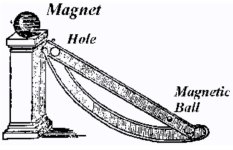Speakpigeon
Contributor
- Joined
- Feb 4, 2009
- Messages
- 6,317
- Location
- Paris, France, EU
- Basic Beliefs
- Rationality (i.e. facts + logic), Scepticism (not just about God but also everything beyond my subjective experience)
Here is an opportunity for experienced engineers to put their technical expertise on display...
Thanks to physicists, metaphysicists, metaphysicians and other people without the relevant expertise to abstain from posting, although you're welcome to look and take notes. It's never too late to learn from those who know these things.
The rough sketch below explains a possible principle for a perpetual motion machine...

Perpetual motion machine
The magnet at the top pulls the metal ball up the ramp. When the ball gets at
the top of the ramp, it drops through to the hole and returns by the curved slope
to the bottom of the ramp, where it is again attracted up the ramp by the magnet.
So, what improvements do you think would have to be made to improve the contraption to the extent that the ball would do at least a few cycles?
Please note that the general principle should not be affected by your improvements.
Thank you to limit yourself to three or four modifications at most.
Thank you also to explain the modifications you propose.
EB
Thanks to physicists, metaphysicists, metaphysicians and other people without the relevant expertise to abstain from posting, although you're welcome to look and take notes. It's never too late to learn from those who know these things.
The rough sketch below explains a possible principle for a perpetual motion machine...

Perpetual motion machine
The magnet at the top pulls the metal ball up the ramp. When the ball gets at
the top of the ramp, it drops through to the hole and returns by the curved slope
to the bottom of the ramp, where it is again attracted up the ramp by the magnet.
So, what improvements do you think would have to be made to improve the contraption to the extent that the ball would do at least a few cycles?
Please note that the general principle should not be affected by your improvements.
Thank you to limit yourself to three or four modifications at most.
Thank you also to explain the modifications you propose.
EB

